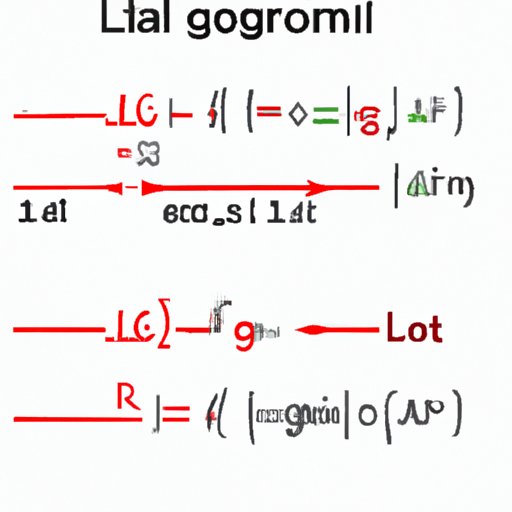
Introduction
Logarithms are a mathematical tool used to help solve complex equations and understand relationships involving large numbers or exponential functions. From chemistry to finance to physics, logarithmic calculations are used widely in many fields. In this article, we will explore how to solve different types of log equations using step-by-step instructions, helpful tips and tricks, and interactive examples.
Step-by-Step Tutorial
A logarithm is the inverse of an exponential function and is represented by the formula y = logb(x), where b is the base of the logarithm, x is the argument, and y is the result. Logarithmic functions exist in different bases, but the most commonly used ones are the natural logarithm, denoted by ln, and the common logarithm, denoted by log. Natural logarithms are logarithms with base e, a mathematical constant equal to approximately 2.71828, while common logarithms have base 10.
Before diving into solving log equations, it is important to understand the various types of logarithmic equations you may encounter. Some of the common examples include:
- Logarithmic equations with a single logarithm: These are equations in which there is only one logarithm on each side of the equation.
- Exponential equations: These are equations where the variable appears in the exponent of a base number.
- Logarithmic equations with multiple logarithms: These are equations that involve two or more logarithms on each side of the equation.
Now, let’s walk through a step-by-step process for solving log equations with examples:
- Step 1: Identify the type of equation and the base of the logarithm.
- Step 2: Use the properties of logarithms to simplify the equation where possible.
- Step 3: Convert the equation into exponential form if necessary.
- Step 4: Solve for the variable.
- Step 5: Check your answer.
Let’s see this process in action with an example:
Example 1: log4(5x-3) – log4(3x+2) = 2
To solve this equation, start by using the quotient rule of logarithms:
log4(5x-3) – log4(3x+2) = log4((5x-3)/(3x+2))) = 2
Next, convert the equation to exponential form:
42 = (5x-3)/(3x+2)
Solve for x:
16(3x+2) = 5x-3
45x = 31
x = 31/45
Finally, check your answer:
log4((5(31/45))-3) – log4((3(31/45))+2) = 2
log4(2) – log4((4/3)) = 2
1/2 – 1/2 = 2
0 = 0
If the equation is not solved with this method, move on to applying the other logarithmic rules. Simplify each expression progressively until you can isolate the variable. It is important to know the logarithmic rules to find the correct solutions.
Here are some tips and tricks for simplifying log equations, making the process easier:
- Memorize the logarithmic properties. This will make working with log equations much easier. One common property is the power rule: logb(xy) = y•logb(x).
- Try to simplify before using any logarithmic rules.
- Watch out for negative or zero arguments in logarithms, this will cause an error. Remember that the logarithm of zero is not defined.
- Always verify your solution by plugging it back into the original equation.
Common Mistakes to Avoid
Working with logarithmic equations can be challenging, and mistakes are common. Here are some common mistakes, and how to avoid them:
- Mistake: Trying to add or subtract logarithms with different bases.
- Solution: Use the change of base formula to convert the logarithms to the same base.
- Mistake: Taking the logarithm of a negative number.
- Solution: Remember that the logarithm of a negative number is undefined, so be sure to check for negative arguments before solving.
- Mistake: Confusing the base of the logarithm.
- Solution: Make sure to clearly identify the base of each logarithm in the equation.
- Mistake: Forgetting to check the solution.
- Solution: Always check your solution by plugging it back into the original equation.
Real-World Applications
Logarithms are used in a variety of fields. Here are some practical applications of logarithmic equations:
- In physics, logarithmic functions are used to express relationships involving sound waves and the frequency of electromagnetic waves.
- In chemistry, logarithmic calculations are used to determine pH levels and concentrations of solutions.
- In finance, logarithmic functions are used to calculate compound interest rates and stock returns.
Understanding logarithmic equations can also be useful in daily life. For example, they can be used for working with large numbers, understanding population growth, and calculating earthquake intensity.
Interactive Example Problems
When it comes to learning how to solve log equations, active practice and engagement can make all the difference. Here are some interactive example problems to help solidify your understanding:
Example 2: Solve for x: 7log(x) – 5 = 0
Click for solution
Example 3: Solve for y: log2(y+1) + log2(y-3) = 2
Click for solution
Having interactive examples like these allows students to reinforce what they’ve learned and get instant feedback on their progress. The pop-up solutions shown in this article will help you understand not only why an answer is correct but also how to arrive at the answer step-by-step.
Video Tutorial
For a visual aid that can help with the understanding of logarithmic functions, watch this video tutorial:
Click to watch the video tutorial
It covers the basics of log equations and demonstrates how to solve diverse cases of logarithmic equations, including practical problems found in everyday life. Not only will this tutorial provide additional guidance, but it may reveal new tips and tricks you can use to further refine your log equation solving skills.
Conclusion
Log equations may seem daunting, but with a basic understanding of logarithms and some practice, you can easily solve them using the step-by-step tutorial presented in this article. Always remember to avoid common mistakes by checking your logarithms and making sure you’re using the correct bases. With more experience, you will soon be able to use these calculations for real-life applications, and they will become an important skillset in your toolset for math, science, finance, and more.




